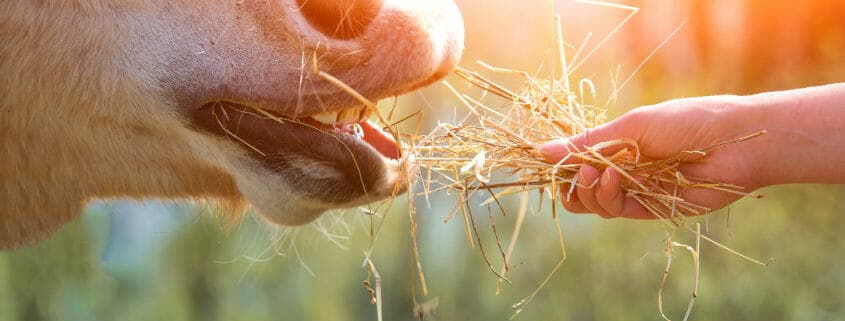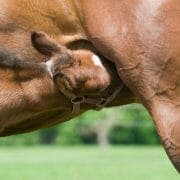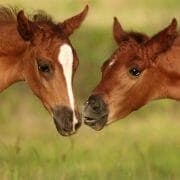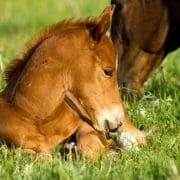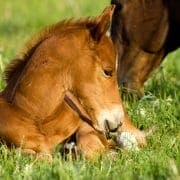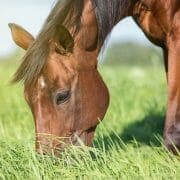Feeding Pregnant Mares
Pregnant mares carry your hopes and dreams, be it for the next big champion or a quiet riding companion. Regardless of what you are breeding, good care of the mare during her various stages of pregnancy has long term impacts on both her and her foal’s long-term health and athletic capacity.
Here are some tips for feeding pregnant mares to keep them healthy and breeding sound, strong and athletic foals:
1. Don’t let mares get fat
Mares in their early stages of pregnancy don’t need many, if any additional calories than they needed when they weren’t in foal. All mares are different, so to really know how much feed your pregnant mares need you should condition score regularly. Pregnant mares should ideally be maintained at a condition score of 6 and should not be allowed to exceed a score of 7. Having mares too fat can:
- Reduce their milk production when they foal.
- Put unnecessary strain on their hooves and joints, making them heavy and uncomfortable.
- Lead to difficulty foaling (though this isn’t necessarily proven to occur).
- Make it difficult to fall pregnant again, particularly if a mare is forced to lose weight just prior to or immediately following foaling.
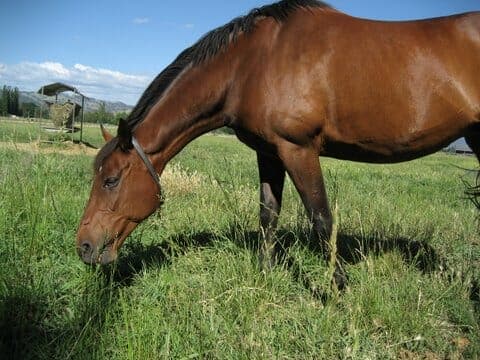
As mares progress through their pregnancy their requirement for energy and protein does increase, so you may find you need to feed additional feed to maintain their body condition score. For more information on Condition Scoring read our blog. If you are feeding pregnant mares, get in the habit of running your hands over them every time you feed them. Doing this means you will quickly pick up if they are putting on more condition than they need and will allow you to adjust their feed intake accordingly.
2. Don’t let mares get skinny
A pregnant mare shouldn’t be allowed to drop below a condition score of 5. Mares that are any lighter will fall away quickly after foaling, reducing the body energy and protein reserves for milk production and also switching off the reproductive cycles, making it difficult or impossible to get in foal again. Thin mares may also be more susceptible to disease.
Again, get in the habit of running your hands over your mares to assess whether they need more feed to hold them in the desired body condition. If you notice their ribs becoming easier to feel or their topline and rump starting to fall away, you will need to increase the amount of feed they are getting. Because so much room is taken up in the mare’s abdomen late in the pregnancy you will likely need to feed high energy grains (make sure they are cooked—see Grains for Horses: Cooked or Uncooked) or high energy fibre feeds that use ingredients like sugarbeet pulp or soybean hulls to allow them to increase their energy intake enough to hold their body condition. High fat feeds are also useful for late pregnant mares.
3. Make sure mineral and vitamin requirements are met
Meeting the mineral and vitamin requirements of pregnant mares during early and late pregnancy is crucial to:
- Promote the sound development of their foals.
- Prevent deficiencies like iodine that can affect the thriftiness and survival of newborn foals.
- Prevent problems in the mares like retained placenta and the associated laminitis.
- Maintain a strong immune system in the mare and foal.
- Maintain the long‐term health and soundness of the mare for future reproduction.
While pregnant mares can often be maintained on good quality pasture with little additional feed, without supplementation of minerals, a pasture‐only diet will almost certainly have quite dramatic deficiencies of copper and zinc and depending on the geographical location may also be very deficient in calcium, phosphorous, magnesium, iodine and selenium.
If the mare doesn’t receive the additional minerals she needs to support herself and her growing foetus, she will draw them from her own body reserves. However, if she is required to do this for many consecutive breeding seasons it will eventually have implications for both her and her future foals’ long‐term health, soundness and athletic ability. One study has shown that foals born to mares early in her breeding career have less structural problems than foals born later in that mare’s life, which may indicate that over consecutive pregnancies, mares can run out of reserves of minerals that directly impact the sound development of her foals.
FeedXL allows you to quickly and easily determine your mare’s requirements for these critical minerals as well as vitamins and helps you make sure the diet you are feeding is meeting her requirements through all stages of pregnancy.
4. Feed high quality protein
During pregnancy a mare requires high quality protein to meet her own requirements and those of her growing foetus. If the pasture your mare is on is of low quality (for example sub‐tropical C4 Type pastures, or pasture that has matured, gone to seed or browned off), add some high quality alfalfa/lucerne hay to raise the quality of protein in the forage component of her diet.
If you are using supplementary feeds on low quality pasture, select feeds that use legumes and oilseeds with quality protein, including soybean, lupins, faba/field beans and canola meal. Low quality protein sources like cottonseed meal shouldn’t be used for pregnant mares. FeedXL will help you make sure you are feeding enough good quality protein to your mares to produce healthy foals and will also stop you from overfeeding protein which will make your mare’s diet very expensive.
5. Make the most of pasture if you have it
Pasture is an excellent source of energy and protein. Feeding a diet that relies largely on pasture has two main positive effects. The first is it will make for an economical diet, with pasture being one of your cheapest feeds available. Secondly, a high fibre diet will keep your mare’s gastrointestinal tract healthy, reducing the risk of problems like colic (something to be avoided in a pregnant mare).
To really know what is in your pasture and what your mare needs in addition for her diet to be balanced, you should have your pasture tested for energy, protein and minerals levels. Once you have had your pasture tested, we can enter the results into your FeedXL account so you can see what is in and what is missing from your specific pasture. Then you only need to add what is missing from the mare’s diet. Equi‐Analytical can run a full analysis starting at $32 USD. It is well worth the investment. If you rely on hay for your mare’s main source of forage this too can be tested and the results put into FeedXL.
Summary
Because it is so often said that a pregnant mare needs little more than a horse at maintenance, it is sometimes mistakenly thought that mares and particularly early pregnant mares can be fed diets of forage only with little or no supplementation. However, while a pasture or good quality hay diet may be sufficient to maintain your mare’s bodyweight, it will almost certainly be lacking in critical nutrient including minerals that can determine if your foal is born structurally sound or not.
Keeping mares in the correct body condition, making sure you meet mineral and vitamins requirements from day 1 of the pregnancy, feeding high quality protein, and using pasture when you can will help you to breed sound foals that are healthy and full of life when born. It will also mean your mares can remain healthy and able to produce strong foals with good structural soundness year in, year out. Being pregnant may not appear to be hard work, but it will take a toll on your mare’s body if she is not properly cared for.
Join FeedXL today and take control of your horse’s nutrition
Get EVEN MORE practical and personalised feeding guidance when you sign up to FEEDXL.
Do you have a question or comment? Do you need help with feeding?
We would love to welcome you to our FeedXL Horse Nutrition Facebook Group. Ask questions and have them answered by PhD and Masters qualified equine nutritionists and spend time with like-minded horse owners. It’s free!
Click here to join the FeedXL Horse Nutrition Facebook Group

